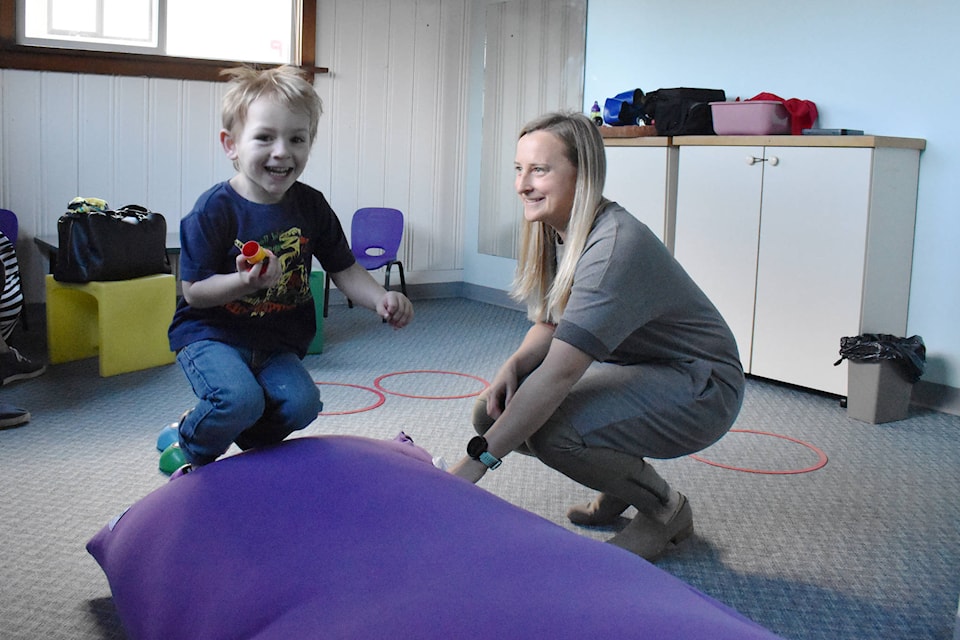The Comox Valley Child Development Association (CVCDA) is a rehab services blessing for parents in this community.
Having one location for physiotherapy (PT), occupational therapy (OT) and speech language pathology is what the experts at the CVCDA like to call “one-stop shopping” for your young child’s rehab needs.
While much of the focus in the past few years has been on The Autism Program (TAP), the early intervention therapy programs - PT, OT and speech - are the cornerstone of the CVCDA.
“We work with kids from birth until they are eligible for school,” said speech language pathologist and therapy program manager Jennifer Lewis.
The first step for every CVCDA client family is an intake consultation - involving any one, or all three, of the rehab service therapists on hand.
“We don’t do any kind of standardized assessment at that time - we are just observing and gathering information from the families, about their child’s strengths and the areas that they are wanting help with. From there we provide suggestions and support, make referrals and so on.”
When Lewis first came to the CVCDA as a speech language pathologist 25 years ago, she was a department of one.
In the 25 years since Lewis first came to the CVCDA, the clientele base in the speech department has more than doubled.
“There are a lot of contributing factors to that,” she said. “The population of the Comox Valley has increased since then - there are a lot more families. There is also an increase in the type of diagnoses - for instance, autism - and that could be [a result of] better screening tools, assessment tools, more eyes out there. There’s no clear reason as to where the increase is coming from. But we are getting a lot more complex cases now.”
Lewis credits the community childcare facilities, and the training provided for such facilities, as one reason for the increase in CVCDA clientele.
“With the increase in community-based services, the kids are out in the community more, and I think those facilities have become quite good at identifying kids that might need some extra support, and talking to those families about getting that extra support. That’s part of it as well.”
She said the one thing that has not increased accordingly is the funding. That’s where the Comox Valley Child Development Association Telethon plays such an important role.
“Yes, that funding has not [increased] as much as we would like it to. So the community support from the Telethon definitely helps support our programs.”
When it comes to speech programs, Lewis said there are clear signs to watch for, regarding a child’s development.
“Usually if kids are not doing a lot of talking by the age of one … 12 to 18 months… that’s something,” she said. “Then sometime kids come to us with a diagnosis of some syndrome and so we can start working with them very early, with some oral motor intervention.”
She said the reasons for using speech language pathology are many.
“We get kids that have neurological conditions, such as cerebral palsy. We have kids that might have Down Syndrome, they might have autism. They might come to us with a cleft palate, or a G-tube (a gastrostomy tube or G-tube, is a tube inserted through the belly that brings nutrition directly to the stomach). So I work with the occupational therapist to work with feeding and try to get them off the tube. So there is a wide range of work we do.”
Lewis said at the CVCDA, it’s all about the “baby steps” - both literally, and figuratively.
“Every child learns differently,” she said. “For some parents, their child is not talking, and to have a session with a family and be able to find the strategies that work to illicit a word, or a sound, it’s so exciting. It may seem to others as such a small thing, but to myself and the families and the kids themselves, it’s very rewarding.”
Difference between PT/OT
“Oh, I get asked that a lot,” said CVCDA occupational therapist Carlin Christensen. “PT is more dealing with the gross motor skills, whereas OT we are dealing with the fine motor skills.”
Gross motor skills are the basic skills most children develop in the first couple of years of life - crawling, balance, standing, walking, running and climbing.
Fine motor skills are more related to co-ordination of the smaller muscles in the hands: grasping, tying shoelaces, using a knife and fork, learning how to zip a zipper.
“We see occupation as anything you do,” said Christensen. “For kids, they need to play, get themselves dressed, they need to eat, go to the bathroom. So in OT, we work on those different areas. ‘Self care’ is dressing, toileting and eating. ‘Productivitiy’ is play.”
Christensen has been with the CVCDA for three and a half years.
She said the relationships she has developed in her time there is the most rewarding part of her job.
“Helping families see their kids’ abilities … helping them see what their children are able to do… that’s so important.”
Much like speech, the clientele for physiotherapy and occupational therapy at the CVCDA have increased considerably in the past few decades, with little, or no increase in funding.
“Therapy equipment is very, very expensive,” said Christensen. “So the funds raised in the telethon always help us with the purchase of therapy equipment that we can then loan to families. So they can try it out before they purchase it themselves, because a lot of families don’t get that kind of funding.”
The 44th annual Comox Valley Child Development Association Telethon takes place Sunday, Nov. 3, noon to 8 p.m. at the Sid Williams Theatre. Admission to the telethon is free and there are many ways onsite to donate to the cause, including raffles, silent auction items and tax deductible donations.Visit www.CVCDA.com for more information.
